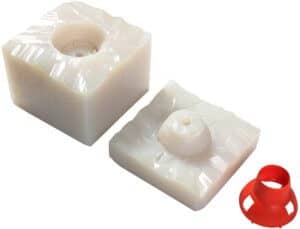Urethane Casting
What is the Cast Urethane Process?

The first step in the urethane casting process is to create the mold from a model or master pattern. Master patterns can be created with CNC machining, 3D printing, or by using an already existing product. The pattern is encased in quick-curing liquid silicone. After the silicone has cured, the mold is cut in half and the model item is removed to reveal a negative. The negative formed by the master pattern is then used for casting the end product.
The silicone mold material is excellent at picking up surface detail and duplicating the surface finish of the master pattern onto the cast urethane parts. The finished dimensions of the urethane cast parts will depend on the accuracy of the master model, part geometry, and casting material.
Vacuum, heat, and pressure are applied during cast urethane molding, resulting in a strong, stable, void-free part. Cast urethane parts are a good choice for quickly producing high quality, precise, and consistent work pieces. Despite the advantages, the urethane casting process can only be used for producing low-volume or prototype parts, as the molds are not durable enough for repeated use.
Is Urethane Casting Expensive?
Cast urethane molding is a relatively inexpensive manufacturing process. The lower cost is mainly due to the speed and ease of mold making for the urethane casting process. Cast urethane molding is done with silicone. The material is inexpensive, easy to work with, can quickly be modified, and will produce detailed cast urethane parts. Urethane casting can cost anywhere from a hundred to a thousand dollars depending on the complexity of the part being molded. Urethane casting is ideal for prototyping and low production runs.
To learn more about urethane casting, click on the menu items in the gray box.
View our Case Studies on CNC machining and injection molding to see how ICOMold has helped customers take their ideas from design concept to the marketplace.
















